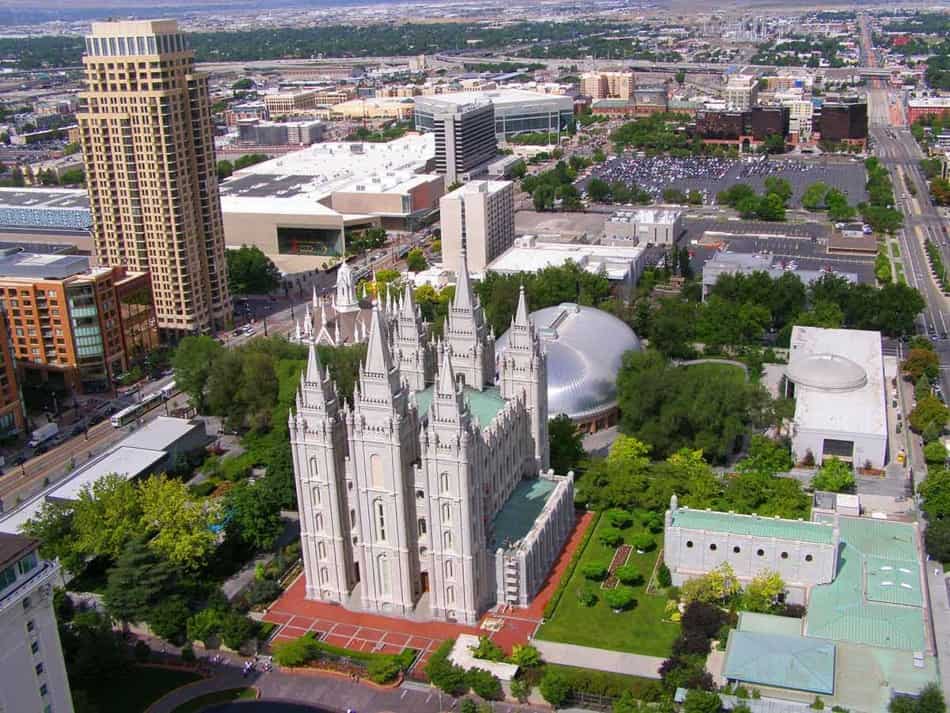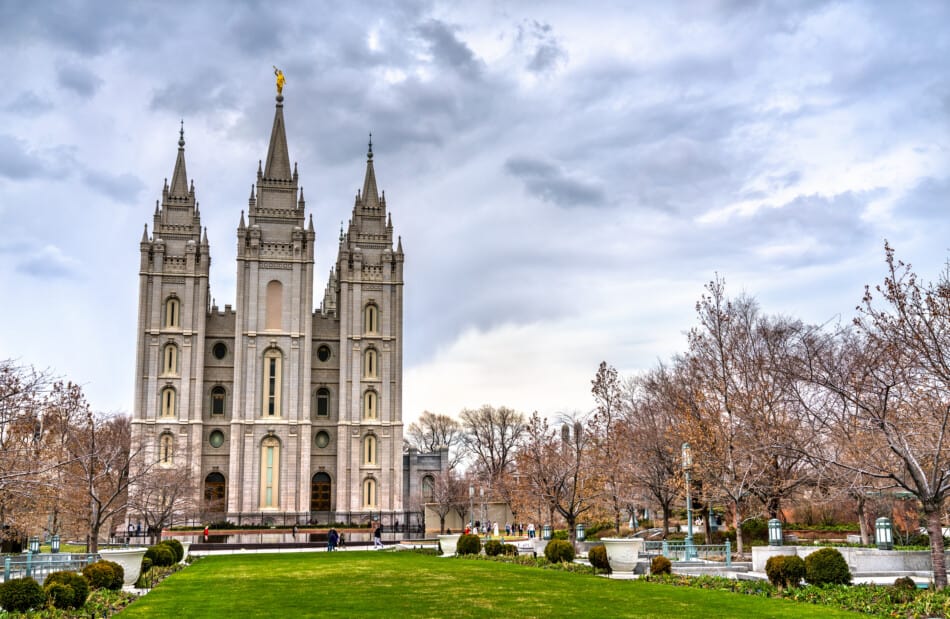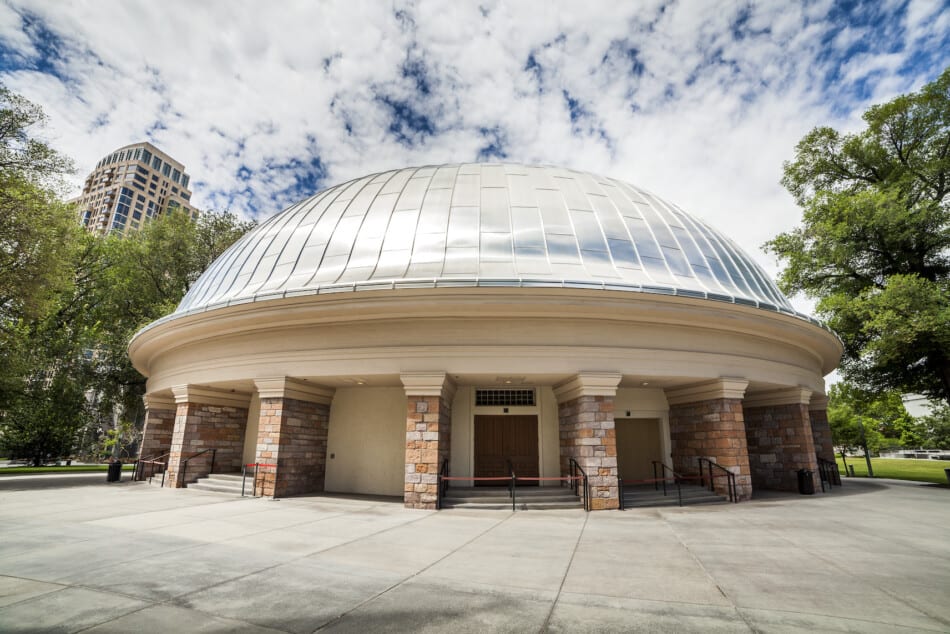15 Amazing Things to do in One Day in Salt Lake City
Are you looking to spend one day in Salt Lake City and wondering what to do? This SLC itinerary covers all of the highlights and is the perfect way to spend a day in Salt Lake City.

Use this SLC 1 Day itinerary to have an unforgettable trip. I’ve also included links to my other helpful articles on Salt Lake City through the post if you are looking for places to eat or where to stay.
Salt Lake City – One Day Itinerary
Temple Square
The Mormons revere Temple Square as a sacred site. Beautiful blossoming trees, bright flowerbeds, fountains, and four significant Mormon buildings: the Mormon Temple, the Mormon Tabernacle, the Temple Annex, and the Assembly Hall spread over 35 acres.

Visit one of the two information centers located at the square’s entrances to learn more about the Church of Jesus Christ of Latter-day Saints. They provide information, and the staff is glad to answer inquiries about the Mormon faith and its history in the area.
This is a relaxing location to stroll around in the spring and summer when the flowers and trees bloom. Several well-known restaurants in the vicinity provide excellent lunch options.
Temple Square, in the heart of Salt Lake City, is open every day from 9 a.m. to 9 p.m. and admission is free.
Brigham Young Monument at Beehive House
The Beehive House, built in 1845, was Brigham Young’s residence as Governor of Utah and leader of the Mormons. For many years, he and his big family of 19 women and 56 children lived here.
Visitors can take free tours of the mansion, which is furnished with many original period artifacts, escorted by church members. The beautiful woodwork on the banisters and genuine woodworking tools used by Brigham Young are some of the highlights.
Enter the square from the south and make your way to the Beehive Building, which is near Eagle Gate, where you will be greeted by a guide who will explain how this tree-shaded house was one of Brigham Young’s dwellings during the formation of the Mormon religion in Utah.
The Salt Lake Temple was also designed by the same architect who designed the Beehive House. Young’s other house, Lion House, is located close by. The guided tour is completely free.
Of architectural note is the beehive on the turret of the house. This is the Mormons’ industriousness symbol, which is also included in the state coat of arms.
Salt Lake Temple
The Salt Lake Temple, a booming LDS church that took over 40 years to build, is one of Utah’s most recognizable sites.

This spectacular six-spire building, which rises 210 feet above the plaza, is the international icon of the Church of Jesus Christ of Latter-day Saints.
While only members of the LDS church are permitted to enter the church, you can still admire its beauty and history from the outside. Walking along the tree-lined paths that loop around the gates, visitors can still see its magnificence from the outside. The structure, which is modeled after Solomon’s Temple, is most stunning when illuminated at night.
Visitors are welcome from 6 to 9 p.m. You don’t have to pay to enjoy the temple’s spectacular architecture and grounds. While you’re here, remember that religious ceremonies like baptisms and weddings are still done regularly at the temple.
Salt Lake Tabernacle
The Salt Lake Tabernacle, a domed building built in 1867 that houses the Mormon Tabernacle Choir and its renowned organ, is another popular attraction in Temple Square.

The tabernacle is a huge oval structure with 44 sandstone piers supporting a dome. Free tours are available throughout the day, and an interesting demonstration of acoustics is given. If you’re lucky, you might be able to attend a free performance or recital that occurs regularly. basis. The gallery for the renowned Tabernacle Choir sits on the west end, and above it is the massive organ with 11,623 pipes.
Until the late 1970s, it was also the home of the Utah Symphony. This structure is breathtaking and is considered an architectural masterpiece.
Natural History Museum
The Natural History Museum of Utah is a fantastic family activity or something to do in Salt Lake City on a chilly or rainy day. The museum, which has 1.6 million pieces in its collection and is housed in a stunning copper-clad concrete edifice with towering spaces, offers more than 40,000 square feet of displays and teaching facilities.
At any given moment, about 5,000 things are on display, with the digital globe, dinosaur fossils, and a three-story indoor canyon among the attractions. Paleontology, Anthropology, Entomology, Vertebrate Zoology, Mineralogy, Botany, and Malacology are among the permanent collections.
The Backyard exhibit will appeal to children the most, with plenty of hands-on activities to pique their interest, while recent visitors report the entire museum is family-friendly, with enough to see and do.
The museum is located in the spectacular Rio Tinto Center, built-in 2011. It emphasizes and showcases the natural history of Utah and the Intermountain West.
Lion House
Brigham Young, the first governor of Utah, lived in Salt Lake City’s Lion House. Built in 1856, the beautiful homestead has been lovingly restored to its former splendor. Look up at the building from the street and admire its front entrance, which is guarded by a large statue of a lion. The magnificent home now houses a restaurant, and the expansive halls are used for gatherings.
Brigham Young, sometimes known as the “Lion of the Lord,” was a well-known figure in the church who served as president between 1847 and 1877. The structure was built in the 1850s to accommodate the president’s large family.
Enter the Lion House Pantry by walking down the short stairwell into the building. This exquisite restaurant, located on the first level of the home, radiates a pioneer-style feel. Enjoy the genuine 19th-century décor and traditional Western hospitality by taking a seat in the restaurant. The restaurant and accompanying parlor rooms are elegantly designed with antiques.
The Lion House Bakery offers freshly baked items, including house-made pies, bread, and desserts. Seminars, receptions, and banquets can be held at the Lion House, which has excellent facilities and a lovely landscape.
For patrons of the Lion House Pantry restaurant, entry to the Lion House is free. The restaurant is open every day except on Sundays.
Assembly Hall
Assembly Hall, a Victorian Gothic structure that holds hour-long concerts for visitors, is a stunning building worth visiting in Temple Square.
The Assembly Hall on Temple Square, one of Salt Lake City’s most iconic structures, was constructed in the Gothic style from 1877 to 1882, utilizing primarily stone left over from the temple construction process.
Today, the Assembly Hall is used primarily for free weekend concerts featuring local and international artists. If you attend on a Friday or Saturday evening, be aware that the concerts are free and do not require tickets, albeit admission is limited to those aged eight and up.
The Seagull Monument is located directly east of the Assembly Hall and commemorates the 1848 occurrence in which a swarm of native seagulls consumed hordes of crickets that threatened the pioneers’ first spring season crops in Utah.
These pioneers, who had been hoping for divine intervention to rescue their crops, called the occurrence a miracle and created this memorial in 1913.
Handcart Pioneer Monument
The Handcart Pioneer Monument honors the hundreds of courageous Mormon pioneers who journeyed through the rugged plains in the 1850s, pulling and pushing all of their belongings in handcrafted, all-wood handcarts since they couldn’t afford the larger ox-drawn wagons.
Around 250 people died on the expedition, but nearly 3,000 people, largely British converts, made it from Iowa City to the Salt Lake Valley. Today, many Latter-day Saints joyfully relate the difficulties and successes of their forefathers who were Mormon handcart pioneers.
The Handcart Pioneers (also known as the Handcart Pioneers Monument) is a bronze sculpture by Torleif S. Knaphus that was put in Temple Square in Salt Lake City, Utah, in 1926.
The sculpture is roughly 6 x 4 x 10 feet in size and sits atop a stone base that is approximately 1 x 5 x 12 feet in size. It shows individuals pushing a handcart; most are pulling the loaded cart, with one young boy pushing from behind.
Pioneer Log Home
Visiting the ancient pioneer buildings and homes is one of the exciting things to do in Salt Lake City for tourists. This pioneer log cabin was built in 1847, the year the Mormons landed in the Salt Lake Valley for the first time.
Osmyn the blacksmith, his wife, Mary Deuel, and Osmyn’s brother live here. The pioneer log home, composed of Douglas fir and lodgepole pine from the mountains east of Salt Lake City, is 15 feet wide and 20 feet long. It is one of only two 1847 log homes that have survived.
When you visit this home today, you’ll find a fully restored and authentically furnished log cabin inside, along with pioneer artifacts like the home’s original cast iron furnace.
The house provides a “great insight into the lifestyle of the Mormon pioneers” and others who populated the once-uncharted American West.
Liberty Park
Visit Liberty Park if you’re looking to relax and enjoy some fresh air. This is Salt Lake City’s second-largest park, and you will find everything from walking and running paths to pools, to a children’s amusement park, and more!
Liberty Park in Salt Lake City’s largest public park, covering more than 80 acres and offering a variety of recreational opportunities. Many residents come here in the summer to picnic or rest under the shady canopy of leaves since this green space is a tremendous natural retreat with mature trees.
The Park has numerous things to do, including tennis courts, bocce ball courts, basketball courts, and a public swimming pool, making it ideal for family outings. Fitness enthusiasts will appreciate the two jogging pathways, one paved and the other covered with woodchips. The Tracy Aviary is also located in the park.
Chase Mill, on the outskirts of Tracy Aviary, is also on the National Register of Historic Places. Built in 1852, Chase Mill is the oldest commercial building in the state. Large drum circles are held on Sundays in Liberty Park, which is a popular day for visits. People of various ages and walks of life can be seen drumming and singing along.
Family History Library
The Family History Library, located in Temple Square, holds millions of genealogy documents profiling more than three billion deceased people, making it the world’s largest library of its sort. The library was established in the late 1800s to aid members of the Church of Jesus Christ of Latter-day Saints in piecing together their family histories.
Today, visitors are welcome to peruse the records, which have been painstakingly preserved, in the hopes of finding a few ancestors. The staff is courteous and highly helpful, and the resources are remarkable. Hence, this is a must-visit location for everyone, especially genealogy buffs.
The library suggests that you plan by categorizing any existing family information and deciding what you wish to find. This will assist the reference consultant in helping you with your search.
The Family History Library, one of the world’s largest genealogy libraries, is open Monday through Friday from 9 a.m. to 5 p.m. and is a must-see for anybody interested in learning more about the LDS Church’s family trees.
Joseph Smith Memorial Building
The Joseph Smith Memorial Building, formerly known as Hotel Utah, was built in honor of the LDS Church’s founder and is currently a multi-purpose admin office and social center.
The Joseph Smith Memorial Building is a prominent structure on Temple Square. It was built in 1911 and was originally known as the Hotel Utah before being changed in honor of the Mormon Church’s first president.
The structure is ten stories tall and built of glazed terra-cotta bricks that reflect the strong Utah sun. Inside, attractions like marble columns, art glass, and the grand staircase are well worth seeing.
The Legacy Theater, conference rooms, the FamilySearch Center, and three restaurants are also on-site, including a rooftop on the 10th floor, which has spectacular views of Temple Square and the city.
Living Room Lookout Trail
If you want to get out of the city and experience some of Utah’s natural beauty, head to the Living Room Lookout Trailhead near the University of Utah, which is just next to the Natural History Museum of Utah.
The 2.3-mile hike is an out-and-back trail with a moderate level of difficulty that is adjacent to Red Butte Gardens (a concert amphitheater as well as a beautiful botanical garden) and is an excellent spot to get your feet moving!
The trail is frequently very crowded, and parking is available nearby on Huntsman Way. The trail is notorious for being narrow, with little shade along the way! Prepare yourself accordingly!
The view from the top provides a unique appreciation and viewpoint of the Salt Lake Valley—it is highly recommended!
Clark Planetarium
The Clark Planetarium in Salt Lake City is worth visiting if you’re traveling with children or enjoy visiting planetariums. It’s also a great rainy-day option for your Salt Lake City itinerary!
Free interactive exhibitions, IMAX performances, and more can be found at the SLC Planetarium. The theater was America’s first pitiless dome planetarium, and the ‘Science of a Sphere’ computer animation globe is a must-see!
Red Butte Garden
Locals frequently bring blankets and refreshments to these fascinating botanical gardens, where they may enjoy quiet and relaxation while seeing the wonderful diversity of blooms on display. The gardens host a variety of events, including guided tours and activities for children.
With finely landscaped plots, bubbling fountains, and attractive walks, Red Butte Garden is a wonderful site for budding botanists as well as those wishing for a quiet respite. The garden is divided into parts, each devoted to a unique type of plant or environment, and is located on the University of Utah campus in northeast Salt Lake City.
There’s plenty to see here, so plan on spending the better part of your day here. Bringing your picnic blanket is also recommended for a concert here during the warmer months. A range of educational talks and kid-friendly activities are also held at Red Butte Garden.
The Red Butte Garden is open from 9 a.m. all year. to 5 p.m. every day. Keep in mind that on days when the garden is hosting a concert, it closes early.
Recent Posts
Discover the Top 19 Unforgettable Day Trips Just Hours from Vegas! Are you looking for day trips from Vegas? Whether you are looking to get away from the strip or are using Vegas as a base...
Vegas Fine Dining: A Tour of 15 Exquisite Upscale Dining Destinations Welcome to the ultimate guide to upscale dining in Las Vegas! Whether you're a seasoned foodie or simply seeking a taste of...
